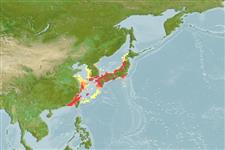分類 / Names
俗名 | 同種異名 | Catalog of Fishes(屬, 種) | ITIS | CoL | WoRMS | Cloffa
Teleostei >
Osmeriformes (Freshwater smelts)
胡瓜魚目 (Freshwater smelts) >
Plecoglossidae (Ayu fish)
香魚科 (Ayu fish)
Etymology: Plecoglossus: Greek, pleko, plekein = to fold + Greek, glossa = tongue (Ref. 45335).
More on authors: Temminck & Schlegel.
Issue
All subspecies of Plecoglossus altivelis (Temminck & Schlegel, 1846) are synonymised under the species in Eschmeyer (CofF ver. Jul. 2010: Ref. 84883). Please send references, or more studies are needed.
Environment: milieu / climate zone / depth range / distribution range
生態學
海洋; 淡水; 半鹹淡水 居於水底的; 非產卵性溯降河的 (Ref. 51243); 深度上下限 10 - ? m. 亞熱帶的; 44°N - 23°N
Northwest Pacific: western Hokkaido in Japan southward to the Korean Peninsula, Taiwan and China.
西北太平洋: 在日本向南至朝鮮半島,台灣與中國的北海道西部。 一個亞種 琉球香魚〔Plecoglossus altivelis ryukyuensis〕 出現於 Nansei 中-shoto ,日本.(參考文獻 34989)
Length at first maturity / 大小 / 重量 / 年齡
Maturity: Lm 27.5, range 30 - 40 cm
Max length : 70.0 cm TL 雄魚/尚未辨別雌雄; (Ref. 12218); common length : 15.0 cm SL 雄魚/尚未辨別雌雄; (Ref. 35840); 最大年齡: 3.00 年 (Ref. 12218)
背棘 (總數) : 0; 背的軟條 (總數) : 10 - 11; 臀鰭軟條: 14 - 15; 脊椎骨: 60 - 63. Pyloric caeca 350-400.
幽門盲囊 350-400.
Typical amphidromous fish; appears in near shore from late autumn to spring (Ref. 11230). Found in lakes and rivers, preferring clean river water and can be found the entire river long, from the head to the mouth (Ref. 12218). Ascends the river during March when the temperature is around 10°C (Ref. 12218). Adults spawn in the spring, in the lower reaches of rivers. After spawning, some adults die while others return to the sea. Larvae enter the sea immediately after hatching and remain there during winter, feeding on plankton. In springtime, the young (5-7 cm TL) move upstream to the middle reaches of rivers to feed on algae. Fish (about 6-9 cm) start schooling at the river mouth and are insectivores and eat algae
off small pebbles (Ref. 12218); this is assisted by small leaf-like teeth which are loosely attached to the jaw with two ligaments (Ref. 45181). Those that are ready to spawn (about 20 cm TL) move downstream to the lower reaches of the river. Spawning adults from the sea migrate upstream to the lower reaches as well. Some fish spawn two or three years in succession, others only once (Ref. 9987 & 559). River forms live usually only one year whereas lake forms can live two or three years (Ref. 12218). Reaches maturity at 30-40 cm (Ref. 12218). Highly esteemed food fish. Marketed fresh and consumed fresh, fried and broiled (Ref. 9987).
典型的河海兩域洄游的魚; 在從秋季末到春天的近岸出現。 (參考文獻 11230) 發現於湖與河了, 偏愛乾淨的河水而且被發現於整個的河長的, 從頭部對嘴巴.(參考文獻 12218) 在溫度是大約 10 °C 的三月期間上溯到河。 (參考文獻 12218) 成魚產卵於春天中,在河的下面範圍方面。 在產卵之後,當其它回到海洋的時候,一些成魚死。 仔魚在孵化之後緊鄰進入海洋而且在冬天期間逗留在那裡, 吃浮游生物。 在春天, 幼魚 (5-7 公分TL) 移動溯河到河的中游覓食藻類。 魚 (大約 6-9 公分) 開始在河嘴群游而且是食蟲動物而且吃藻類
外海的小小圓石;(參考文獻 12218) 這被小葉狀的齒協助鬆弛地那是依附於頜有兩個結帶.(參考文獻 45181) 那些那是預備好的狀態產卵 (大約 20 公分TL) 移動向下到河的下面範圍。 產卵的成魚距離海洋移動也溯河到下面的範圍。 一些魚在連續方面產卵二或三年, 其它是只有一次 (參考文獻 9987&559). 然而湖表格能生活二或三年,河表格通常生活只有一年。 (參考文獻 12218) 在 30-40 公分達到成熟。 (參考文獻 12218) 深受喜愛的食用魚。 在市場上銷售生鮮地而且生鮮消費, 油炸了而且火烤了。 (參考文獻 9987)
Life cycle and mating behavior
成熟度 | 繁殖 | 產卵場 | 卵 | 孕卵數 | 仔魚
During spawning some fish go up the river and some fish spawn on the river shoreline above pebbles. Spawns at night and excavates a 10cm (diameter or depth?) pit. Eggs are around 1 mm in size and adhere to the sand or pebbles for 14 to 20 days before hatching. This fish is semelparous and releases eggs many times over a short period each time releasing ~10,000 eggs. Sometimes females that want to spawn but cannot, save their strength, and go to a deep stagnant pool. These females wait until spring before going up the river with young fish. After hatching, the larvae are 6 mm and flow with the water current eating plankton. Juvenile fish will come again to the river in spring. These live in schools. When schools of Plecoglossus altivelis return to their river they guard their territory and eat food (Ref. 12218).
Reproductive mode varies between semelparity and iteroparity. Large females spawn once, while smaller females spawn twice during a two-week interval (Ref. 76896).西北太平洋: 在日本向南至朝鮮半島,台灣與中國的北海道西部。 一個亞種 琉球香魚〔Plecoglossus altivelis ryukyuensis〕 出現於 Nansei 中-shoto ,日本.(參考文獻 34989)
Masuda, H., K. Amaoka, C. Araga, T. Uyeno and T. Yoshino, 1984. The fishes of the Japanese Archipelago. Vol. 1. Tokai University Press, Tokyo, Japan. 437 p. (text). (Ref. 559)
IUCN 瀕危狀態 (Ref. 130435: Version 2024-1)
人類使用
漁業: 高經濟性; 養殖: 商業性; 游釣魚種: 是的
工具
特別的報告
下載 XML
網路資源
Estimates based on models
Preferred temperature (Ref.
123201): 13 - 22.6, mean 19.7 °C (based on 42 cells).
Phylogenetic diversity index (Ref.
82804): PD
50 = 1.5000 [Uniqueness, from 0.5 = low to 2.0 = high].
Bayesian length-weight: a=0.00427 (0.00166 - 0.01096), b=3.06 (2.83 - 3.29), in cm total length, based on LWR estimates for this (Sub)family-body shape (Ref.
93245).
營養階層 (Ref.
69278): 2.8 ±0.16 se; based on food items.
回復力 (Ref.
120179): 高度, 族群倍增時間少於 15個月 (tm=1; tmax=3; Fec=50,000-100,000).
Fishing Vulnerability (Ref.
59153): Moderate to high vulnerability (48 of 100).
Nutrients (Ref.
124155): Calcium = 78 [36, 203] mg/100g; Iron = 1.19 [0.62, 2.98] mg/100g; Protein = 16.2 [13.8, 18.2] %; Omega3 = 0.445 [0.196, 1.234] g/100g; Selenium = 73.2 [35.2, 156.1] μg/100g; VitaminA = 4.44 [1.39, 14.45] μg/100g; Zinc = 0.804 [0.513, 1.253] mg/100g (wet weight);
